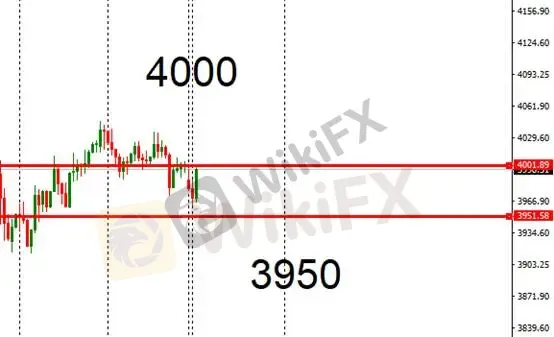简体中文
繁體中文
English
Pусский
日本語
ภาษาไทย
Tiếng Việt
Bahasa Indonesia
Español
हिन्दी
Filippiiniläinen
Français
Deutsch
Português
Türkçe
한국어
العربية
U.S. Government Shutdown Nears Historic Record as Economic Fallout Deepens
Sommario:Heres the professional American English translation of your article, written in the tone of a financial market analyst. The chart annotations have also been translated for publication use.U.S. Governm
Heres the professional American English translation of your article, written in the tone of a financial market analyst. The chart annotations have also been translated for publication use.
U.S. Government Shutdown Nears Historic Record as Economic Fallout Deepens
The U.S. government shutdown has entered its 32nd day—just shy of the 35-day record set in late 2018. The ongoing fiscal stalemate has paralyzed federal operations and raised the risk of disruption to key public services. As funding for the Supplemental Nutrition Assistance Program (SNAP), which supports roughly 42 million Americans, is set to expire on November 1, the nation faces a potential social crisis. Although the Senate plans another vote on November 3, partisan gridlock between Republicans and Democrats continues over core fiscal issues.
U.S. Treasury Secretary Bessent told the media that the American economy is in a “transitional phase,” with some sectors—particularly real estate—already in recession. He suggested that if inflation continues to decline, the Federal Reserve should consider further rate cuts to ease mortgage rates and revive the housing market. Bessent also revealed that President Trump has yet to impose the planned 10% tariff on Canada, adding that “we will eventually reconcile with our family members and renegotiate with Canada.” His remarks hint at potential policy softening on the trade front.
Following the October FOMC meeting, the Federal Reserve witnessed a rare “dual dissent.” Of the 12 voting members, two opposed the final decision—Governor Milan favored a 50-basis-point rate cut, while Kansas Fed President Jeff Schmid argued for keeping rates unchanged. This marked the first such split in six years, underscoring deep divisions within the policy committee regarding the economic outlook.
Recent market data show that the probability of another Fed rate cut by year-end has dropped sharply—from 92% before Chair Powell‘s remarks to 61% after. Schmid noted that inflation remains elevated, while next year’s voting member Lorie Logan emphasized that she would only support a December cut if there are clear signs of rapidly declining inflation. In contrast, Governor Waller maintained that if current economic trends persist, theres still room for a December rate cut.
Analysts broadly agree that the Feds December policy decision may hinge on the duration of the shutdown. Should it extend past Thanksgiving, the absence of official economic data could leave the Fed flying blind—potentially forcing a pause in rate cuts. More optimistic forecasts expect the government to reopen within two weeks, allowing the Fed to access fresh employment and inflation data before the December meeting, which could justify another 25-basis-point cut.
At present, the U.S. economy stands at the crossroads of high inflation and slowing growth. The convergence of a government shutdown, widening fiscal deficit, and trade uncertainty has created an exceptionally complex policy environment. The Feds internal split not only reflects conflicting data but also highlights the limits of its policy tools. If the shutdown persists into mid-November, market volatility could intensify, with the U.S. dollar and Treasuries coming under pressure, while gold and other safe-haven assets may benefit. Conversely, if fiscal negotiations progress and inflation continues to ease, the Fed could extend its rate-cut cycle in December, injecting new confidence into the markets.
Gold Technical Analysis

Gold prices have returned to a key pivot zone near $4,000/oz, signaling a possible shift in market sentiment.
If prices break above $4,000, traders may consider long positions.
If not, expect range-bound trading between $3,950–$4,000, adopting a sell-high, buy-low strategy with stop-losses around $10–$20 away.
Resistance: $4,000/oz
Support: $3,950/oz
Risk Disclaimer
The above analysis, opinions, and price projections are provided for general market commentary only and do not represent the views of this platform. All readers should exercise independent judgment and assume full responsibility for their trading decisions. Trade cautiously.
Disclaimer:
Le opinioni di questo articolo rappresentano solo le opinioni personali dell’autore e non costituiscono consulenza in materia di investimenti per questa piattaforma. La piattaforma non garantisce l’accuratezza, la completezza e la tempestività delle informazioni relative all’articolo, né è responsabile delle perdite causate dall’uso o dall’affidamento delle informazioni relative all’articolo.
WikiFX Trader
ATFX
Ultima
IC Markets Global
D prime
Vantage
XM
ATFX
Ultima
IC Markets Global
D prime
Vantage
XM
WikiFX Trader
ATFX
Ultima
IC Markets Global
D prime
Vantage
XM
ATFX
Ultima
IC Markets Global
D prime
Vantage
XM
Rate Calc




